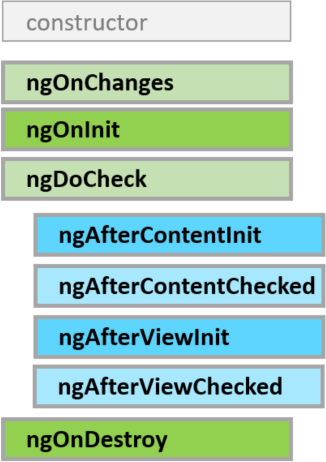
A component has a lifecycle managed by Angular.
Angular creates it, renders it, creates and renders its children, checks it when its data-bound properties change, and destroys it before removing it from the DOM.
Angular offers lifecycle hooks that provide visibility into these key life moments and the ability to act when they occur.
A directive has the same set of lifecycle hooks, minus the hooks that are specific to component content and views.
Contents
- Component lifecycle hooks overview
- Lifecycle sequence
- Interfaces are optional (technically)
- Other Angular lifecycle hooks
- Lifecycle examples
- Peek-a-boo: all hooks
- Spying OnInit and OnDestroy
- OnChanges
- DoCheck
- AfterView
- AfterContent
Try the
Component lifecycle hooks overview
Directive and component instances have a lifecycle
as Angular creates, updates, and destroys them.
Developers can tap into key moments in that lifecycle by implementing
one or more of the lifecycle hook interfaces in the Angular core library.
Each interface has a single hook method whose name is the interface name prefixed with ng.
For example, the OnInit interface has a hook method named ngOnInit()
that Angular calls shortly after creating the component:
peek-a-boo.component.ts (excerpt)
No directive or component will implement all of the lifecycle hooks and some of the hooks only make sense for components. Angular only calls a directive/component hook method if it is defined.
Lifecycle sequence
After creating a component/directive by calling its constructor, Angular calls the lifecycle hook methods in the following sequence at specific moments:
| Hook | Purpose and Timing |
|---|---|
ngOnChanges() | Respond when Angular (re)sets data-bound input properties.
The method receives a Called before |
ngOnInit() | Initialize the directive/component after Angular first displays the data-bound properties and sets the directive/component's input properties. Called once, after the first |
ngDoCheck() | Detect and act upon changes that Angular can't or won't detect on its own. Called during every change detection run, immediately after |
ngAfterContentInit() | Respond after Angular projects external content into the component's view. Called once after the first A component-only hook. |
ngAfterContentChecked() | Respond after Angular checks the content projected into the component. Called after the A component-only hook. |
ngAfterViewInit() | Respond after Angular initializes the component's views and child views. Called once after the first A component-only hook. |
ngAfterViewChecked() | Respond after Angular checks the component's views and child views. Called after the A component-only hook. |
ngOnDestroy | Cleanup just before Angular destroys the directive/component. Unsubscribe Observables and detach event handlers to avoid memory leaks. Called just before Angular destroys the directive/component. |
Interfaces are optional (technically)
The interfaces are optional for JavaScript and Typescript developers from a purely technical perspective. The JavaScript language doesn't have interfaces. Angular can't see TypeScript interfaces at runtime because they disappear from the transpiled JavaScript.
Fortunately, they aren't necessary. You don't have to add the lifecycle hook interfaces to directives and components to benefit from the hooks themselves.
Angular instead inspects directive and component classes and calls the hook methods if they are defined.
Angular finds and calls methods like ngOnInit(), with or without the interfaces.
Nonetheless, it's good practice to add interfaces to TypeScript directive classes in order to benefit from strong typing and editor tooling.
Other Angular lifecycle hooks
Other Angular sub-systems may have their own lifecycle hooks apart from these component hooks.
3rd party libraries might implement their hooks as well in order to give developers more control over how these libraries are used.
Lifecycle examples
The AppComponent.
They follow a common pattern: a parent component serves as a test rig for a child component that illustrates one or more of the lifecycle hook methods.
Here's a brief description of each exercise:
| Component | Description |
|---|---|
| Peek-a-boo | Demonstrates every lifecycle hook. Each hook method writes to the on-screen log. |
| Spy | Directives have lifecycle hooks too.
A This example applies the |
| OnChanges | See how Angular calls the |
| DoCheck | Implements an |
| AfterView | Shows what Angular means by a view.
Demonstrates the |
| AfterContent | Shows how to project external content into a component and
how to distinguish projected content from a component's view children.
Demonstrates the |
| Counter | Demonstrates a combination of a component and a directive each with its own hooks. In this example, a |
The remainder of this page discusses selected exercises in further detail.
Peek-a-boo: all hooks
The PeekABooComponent demonstrates all of the hooks in one component.
You would rarely, if ever, implement all of the interfaces like this. The peek-a-boo exists to show how Angular calls the hooks in the expected order.
This snapshot reflects the state of the log after the user clicked the Create... button and then the Destroy... button.
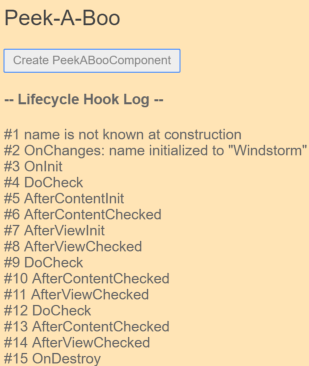
The sequence of log messages follows the prescribed hook calling order:
OnChanges, OnInit, DoCheck (3x), AfterContentInit, AfterContentChecked (3x),
AfterViewInit, AfterViewChecked (3x), and OnDestroy.
The constructor isn't an Angular hook per se.
The log confirms that input properties (the name property in this case) have no assigned values at construction.
Had the user clicked the Update Hero button, the log would show another OnChanges and two more triplets of
DoCheck, AfterContentChecked and AfterViewChecked.
Clearly these three hooks fire often. Keep the logic in these hooks as lean as possible!
The next examples focus on hook details.
Spying OnInit and OnDestroy
Go undercover with these two spy hooks to discover when an element is initialized or destroyed.
This is the perfect infiltration job for a directive. The heroes will never know they're being watched.
Kidding aside, pay attention to two key points:
Angular calls hook methods for directives as well as components.
A spy directive can provide insight into a DOM object that you cannot change directly. Obviously you can't touch the implementation of a native
<div>. You can't modify a third party component either. But you can watch both with a directive.
The sneaky spy directive is simple, consisting almost entirely of ngOnInit() and ngOnDestroy() hooks
that log messages to the parent via an injected LoggerService.
You can apply the spy to any native or component element and it'll be initialized and destroyed
at the same time as that element.
Here it is attached to the repeated hero <div>:
Each spy's birth and death marks the birth and death of the attached hero <div>
with an entry in the Hook Log as seen here:
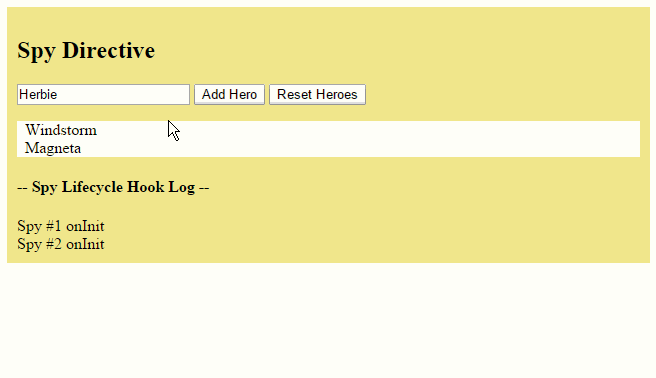
Adding a hero results in a new hero <div>. The spy's ngOnInit() logs that event.
The Reset button clears the heroes list.
Angular removes all hero <div> elements from the DOM and destroys their spy directives at the same time.
The spy's ngOnDestroy() method reports its last moments.
The ngOnInit() and ngOnDestroy() methods have more vital roles to play in real applications.
OnInit()
Use ngOnInit() for two main reasons:
- To perform complex initializations shortly after construction.
- To set up the component after Angular sets the input properties.
Experienced developers agree that components should be cheap and safe to construct.
Misko Hevery, Angular team lead, explains why you should avoid complex constructor logic.
Don't fetch data in a component constructor. You shouldn't worry that a new component will try to contact a remote server when created under test or before you decide to display it. Constructors should do no more than set the initial local variables to simple values.
An ngOnInit() is a good place for a component to fetch its initial data. The
Tour of Heroes Tutorial and HTTP Client
guides show how.
Remember also that a directive's data-bound input properties are not set until after construction.
That's a problem if you need to initialize the directive based on those properties.
They'll have been set when ngOnInit() runs.
The ngOnChanges() method is your first opportunity to access those properties.
Angular calls ngOnChanges() before ngOnInit() and many times after that.
It only calls ngOnInit() once.
You can count on Angular to call the ngOnInit() method soon after creating the component.
That's where the heavy initialization logic belongs.
OnDestroy()
Put cleanup logic in ngOnDestroy(), the logic that must run before Angular destroys the directive.
This is the time to notify another part of the application that the component is going away.
This is the place to free resources that won't be garbage collected automatically. Unsubscribe from Observables and DOM events. Stop interval timers. Unregister all callbacks that this directive registered with global or application services. You risk memory leaks if you neglect to do so.
OnChanges()
Angular calls its ngOnChanges() method whenever it detects changes to input properties of the component (or directive).
This example monitors the OnChanges hook.
on-changes.component.ts (excerpt)
The ngOnChanges() method takes an object that maps each changed property name to a
SimpleChange object holding the current and previous property values.
This hook iterates over the changed properties and logs them.
The example component, OnChangesComponent, has two input properties: hero and power.
The host OnChangesParentComponent binds to them like this:
Here's the sample in action as the user makes changes.
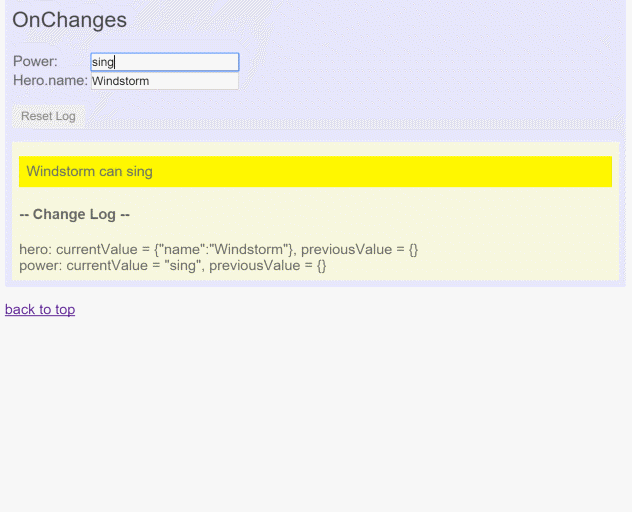
The log entries appear as the string value of the power property changes.
But the ngOnChanges does not catch changes to hero.name
That's surprising at first.
Angular only calls the hook when the value of the input property changes.
The value of the hero property is the reference to the hero object.
Angular doesn't care that the hero's own name property changed.
The hero object reference didn't change so, from Angular's perspective, there is no change to report!
DoCheck()
Use the DoCheck hook to detect and act upon changes that Angular doesn't catch on its own.
Use this method to detect a change that Angular overlooked.
The DoCheck sample extends the OnChanges sample with the following ngDoCheck() hook:
DoCheckComponent (ngDoCheck)
This code inspects certain values of interest, capturing and comparing their current state against previous values.
It writes a special message to the log when there are no substantive changes to the hero or the power
so you can see how often DoCheck is called. The results are illuminating:
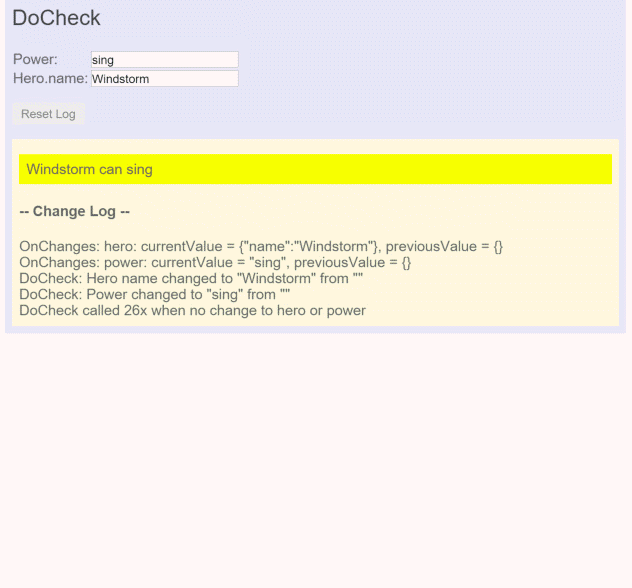
While the ngDoCheck() hook can detect when the hero's name has changed, it has a frightful cost.
This hook is called with enormous frequency—after every
change detection cycle no matter where the change occurred.
It's called over twenty times in this example before the user can do anything.
Most of these initial checks are triggered by Angular's first rendering of unrelated data elsewhere on the page.
Mere mousing into another <input> triggers a call.
Relatively few calls reveal actual changes to pertinent data.
Clearly our implementation must be very lightweight or the user experience suffers.
AfterView
The AfterView sample explores the AfterViewInit() and AfterViewChecked() hooks that Angular calls
after it creates a component's child views.
Here's a child view that displays a hero's name in an <input>:
ChildComponent
The AfterViewComponent displays this child view within its template:
AfterViewComponent (template)
The following hooks take action based on changing values within the child view, which can only be reached by querying for the child view via the property decorated with @ViewChild.
AfterViewComponent (class excerpts)
Abide by the unidirectional data flow rule
The doSomething() method updates the screen when the hero name exceeds 10 characters.
AfterViewComponent (doSomething)
Why does the doSomething() method wait a tick before updating comment?
Angular's unidirectional data flow rule forbids updates to the view after it has been composed. Both of these hooks fire after the component's view has been composed.
Angular throws an error if the hook updates the component's data-bound comment property immediately (try it!).
The LoggerService.tick_then() postpones the log update
for one turn of the browser's JavaScript cycle and that's just long enough.
Here's AfterView in action:
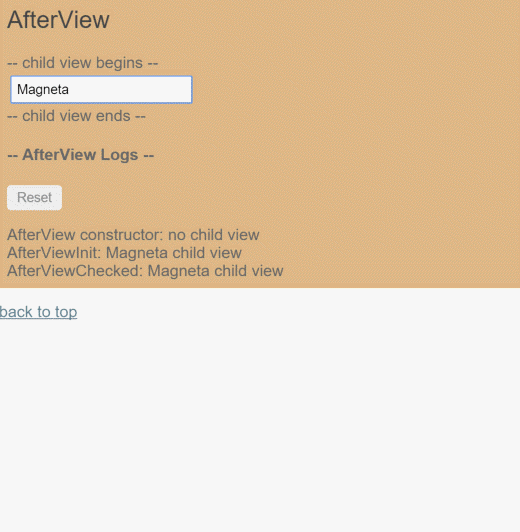
Notice that Angular frequently calls AfterViewChecked(), often when there are no changes of interest.
Write lean hook methods to avoid performance problems.
AfterContent
The AfterContent sample explores the AfterContentInit() and AfterContentChecked() hooks that Angular calls
after Angular projects external content into the component.
Content projection
Content projection is a way to import HTML content from outside the component and insert that content into the component's template in a designated spot.
AngularJS developers know this technique as transclusion.
Consider this variation on the previous AfterView example.
This time, instead of including the child view within the template, it imports the content from
the AfterContentComponent's parent. Here's the parent's template:
AfterContentParentComponent (template excerpt)
Notice that the <my-child> tag is tucked between the <after-content> tags.
Never put content between a component's element tags unless you intend to project that content
into the component.
Now look at the component's template:
AfterContentComponent (template)
The <ng-content> tag is a placeholder for the external content.
It tells Angular where to insert that content.
In this case, the projected content is the <my-child> from the parent.

The telltale signs of content projection are twofold:
- HTML between component element tags.
- The presence of
<ng-content>tags in the component's template.
AfterContent hooks
AfterContent hooks are similar to the AfterView hooks. The key difference is in the child component.
The AfterView hooks concern
ViewChildren, the child components whose element tags appear within the component's template.The AfterContent hooks concern
ContentChildren, the child components that Angular projected into the component.
The following AfterContent hooks take action based on changing values in a content child, which can only be reached by querying for them via the property decorated with @ContentChild.
AfterContentComponent (class excerpts)
No unidirectional flow worries with AfterContent
This component's doSomething() method update's the component's data-bound comment property immediately.
There's no need to wait.
Recall that Angular calls both AfterContent hooks before calling either of the AfterView hooks.
Angular completes composition of the projected content before finishing the composition of this component's view.
There is a small window between the AfterContent... and AfterView... hooks to modify the host view.